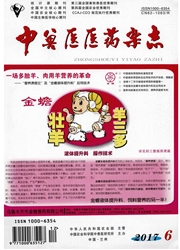

 中文摘要:
中文摘要:
为研究腹泻病理状态下樗白皮提取物对机体氧化还原状态的调节功能,采用番泻叶提取物建立小鼠药物性腹泻模型,经不同剂量樗白皮提取物治疗,对小鼠血清中MDA、SOD、GSH、GSSG、GSH-Px等抗氧化指标进行测定。结果显示,模型组MDA含量较正常组显著升高(P〈0.05),樗白皮提取物不同剂量治疗组均低于模型组,与治疗对照组无显著差异;模型组SOD酶活性显著低于其他各组(P〈0.01),正常对照组与其他实验组之间无显著差异;模型组GSH含量显著低于正常对照组和治疗对照组(P〈0.05),高剂量组和中剂量组高于模型组(P〉0.05),低剂量组与模型组无显著差异;正常对照组GSSG含量显著低于其他各组(P〈0.01),模型组显著高于治疗对照组和高剂量组(P〈0.01),高于中剂量组和低剂量组(P〉0.05);GSH-Px模型组均低于其他各组,除与低剂量组无显著差异外,与其他各组差异均极显著(P〈0.01)。结果表明,樗白皮提取物能够降低腹泻模型小鼠体内氧化性物质含量,提高还原酶活性及促进还原性物质生成,对机体的氧化还原稳态具有一定的调节作用,并且与给药剂量之间存在一定的量效关系。
 英文摘要:
英文摘要:
In order to study the biological functions of extract from Ailanthus altissima on regulating redox state under pathological conditions, the diarrhea model mice were established by using senna extract and the physiological indexes of MDA, SOD, GSH, GSSG and GSH-Px were detected after treating with different doses of Ailanthus altissima extract. The resuhs showed that the content of MDA in model group was significantly higher than that in control group (P〈0.05), the content of MDA in different treated groups were all lower than that in model, and the difference was not significant among the different treated groups and treatment control group; the activities of SOD in the model group was lower than the other groups, and there was no significant difference between the control group and the other groups exeept model group. GSH content in model was significantly lower than that in control and treatment control groups (P〈0.05) and lower than that in high does and middle does groups (P〉0.05), and was equivalent to that in low does group. GSSG content of control was lower significantly than that of the other groups (P〈0.01), the GSSG content of model group was significantly higher than that of the treat control and high does groups (P〈0.01), and higher than that of the middle does and low does groups (/3〉0.05). GSH-Px activities of the model was lower than that of other groups except low does group (P〈0.01). These resuhs showed that Ailanthus altissima extract could decrease oxidizing substance in dian-hea mice, improve reductase activity and the reducing substances, and could regulate the oxidation-reduction dynamic balance with a dose-effect relativity.
 同期刊论文项目
同期刊论文项目
 同项目期刊论文
同项目期刊论文
 期刊信息
期刊信息
